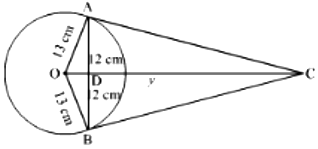
Let O be the centre of the circle and AB and OC intersect at D
Now let CD = y
Since OC is the perpendicular bisector of AB
\(\therefore\) AD = BD
= \(\frac{24}2\) cm
= 12 cm
In right \(\triangle\)OAP
OA2 = AD2 + OD2
⇒ OD2 = OA2 - AD2
= (13 cm)2 - (12 cm)2
= 169 cm2 - 144 cm2
= 25 cm2
⇒ OD = \(\sqrt{25 \,cm^2}\) = 5 cm
In right triangle's OAC and ADC
AC2 = AD2 + DC2
OC2 = OA2 + AC2
⇒ OC2 = OA2 + (AD2 + DC2)
⇒ (CD + OD)2 = (13 cm)2 + (12 cm)2 + y2
⇒ (y + 5 cm)2 = 169 cm2 + 144 cm2 + y2
⇒ y2 + 10y cm + 25 cm2 = 313 cm2 + y2
⇒ 10y = (313 - 25) cm = 288 cm
⇒ y = \(\frac{288}{10} =\frac{144}5\) cm
⇒ CD = 28.8 cm2
\(\therefore\) AC2 = AD2 + DC2
\(=(12 \,cm)^2 + (\frac{144}5 \,cm)^2\)
\(= 144 \,cm^2 + \frac{20736}{25}\, cm^2\)
\(= \frac{3600 \,cm^2 + 20736\, cm^2}{25}\)
\(= \frac{24336}{25} cm^2\)
\(= (\frac{156}{5} cm)^2\)
Hence,
AC = \(\frac{156}5\) = 31.2 cm.